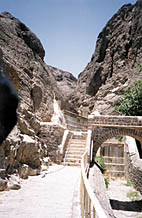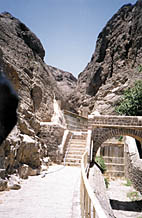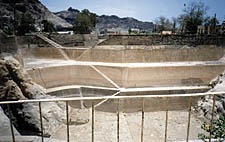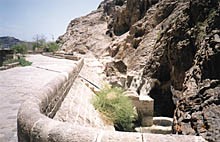
WATER… WATER!! [Archives:1998/37/Last Page]
September 14 1998
The essence of the ancient Yemeni civilization was elaborate dam and cistern building. By harnessing rain water and flash floods through clever networks of cisterns and canals, the ancient Himyarites were able to establish a brilliant civilization – without relying on perennial rivers like their contemporaries in Egypt and Mesopotamia.

The Taweela Cisterns in Aden are such a network. This impressive group of 18 cisterns with a total capacity of 20 million gallons of water is situated in the district of Crater, in the middle of the Taweela Valley. Archeologists date these cistern back to the first century AD during the reign of the Himyarite dynasty, as indicated by the Yemeni historian Hamza Loqman in his book “The History of Aden and Southern Arabia.” The majority of these structures were carved out of solid rock. They were dug into a sloping site, and connected to one another by means of canals running along the valley.
At the top of the valley, a dam was built to prevent rocks and silt from going into the cisterns and blocking the canals. The lake behind the dam is known as Burkat (pool) Anbar.
The first of this series of cisterns is known as Abu Silsila. It has a staircase leading into it, and decorated columns adorning its rim. A gypsum lining runs around the cistern’s inner rim. It has miraculously survived the beating of nature’s elements.
Playfair Discovery
It was widely considered that Captain Playfair, Assistant Political Resident was the first person to discover the Taweela Cisterns in 1845. He indicated that there were 50 cisterns, which could hold 30 million gallons of water. The largest of these cisterns, he said, could hold up to 10 million gallons.
However, Mr. Slott – an intrepid English traveler – visited Aden in 1809. He saw then some of their remains, indicating that three of them were 80 feet wide. ‘They are lined by thin, crystal-like marble,’ he wrote.

The infamous Captain Haines, while sailing through the Gulf of Aden in 1835 (four years before actually invading Aden), noticed that there were similar cisterns in other parts of the region such as Husn Al-Ghurab and Al-Amadia. ‘They are still suitable for storing water, he wrote in his log book. The British colonial forces, however, neglected those other cisterns, and concentrated on the Taweela ones. Renovation work on the latter was begun in 1856.

The Aden Cisterns were not all constructed during the same period of time. More were dug with the population growth and expansion of the city. So it is not possible to attribute the credit of constructing the cisterns to a particular era or to one ruling dynasty.
Some British civil engineers date the cisterns back to pre-Islamic times. This hypothesis is supported by the Russian scientist Serge Stirinsky and the Pakistani engineer Mian Abdulmajid. However, there is very little historic evidence as to the exact time and method of building the Aden Cisterns.
Above Burkat Anbar, there are three stone cisterns known collectively as the Sab’a Duroub (seven roads). They were constructed during the rule of Prince Abu Othman Bin Ali Al-Zanjabili, who ruled Aden on behalf of Bani Ayyub.
What Others Said
The famous Arab traveler Ibn Batouta visited Aden and described its social and economic conditions. He made a fleeting mention of the cisterns and their use for water storage.
During the Egyptian occupation of the region in 1538, it was noted that Aden had no other source of water but its famous cisterns.
Prince Ahmed Bin Fadhl Al-Abdali mentioned in a book these cisterns: ‘Aden is very unique. Its cisterns are one of the most exquisite engineering works in the world. They can hold 80 million gallons of water. Their date of construction is unknown, some historians say they go back to the fifth century AD. They were buried, but discovered by the British in 1272 After Hijra.’
Ridhwan Al-Saqqaf,
Yemen Times, Aden
——
[archive-e:37-v:1998-y:1998-d:1998-09-14-p:./1998/iss37/lastpage.htm]


